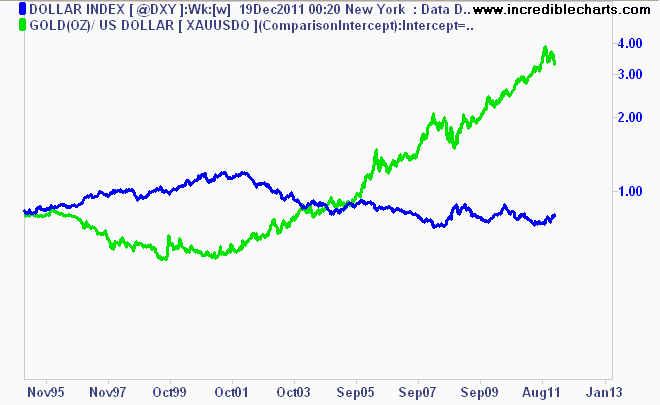I generally don’t mind a bit of the AFR’s commodities commentator, Stephen Wyatt. But today he shows a complete lack of insight into the dynamics that drive the gold market claiming that:
Gold is behaving badly. It’s supposed to be a safe-haven asset but, just when the global economy looks like going to hell in a hand basket, the gold market collapses. It should have rallied.
The gold bugs are bemused, but they are nowhere near raising the white flag.
UBS analysts in a recent note to clients said: “Our core view on gold remains bullish. We forecast an average 2012 price of $2050. Most of the factors that pushed gold higher in 2011 are not going away.”
UBS says a compelling case for higher gold returns next year can be built on persistent sovereign stress, an expected recession in Europe, benign growth across developed markets, a relatively sedate outlook for competing asset classes, still low interest rates in the US and further rate declines in Europe.
Well, that may be great for gold, but if UBS is right it’s the kiss of death for equities and industrial commodities.
Right now, though, this gloom is not even working for gold. Something is wrong.
As the euro zone debt crisis deepens and developed economies hurtle toward recession, the gold price has slumped to its lowest level since September while the US dollar has soared.
The gold price tumbled almost 9 per cent to $US1560 a troy ounce at one stage last week and gold is still trading below $US1600. It broke down below its 200-day moving average for the first time in almost three years.
Rather than gold being the primary safe-haven asset, US dollars and US treasuries have become the preferred safe-haven asset classes. The US dollar’s position as the world’s reserve currency gives it the advantage of liquidity and in very turbulent times investors seem to prefer liquidity to less liquid assets, even if those assets are seen as safe havens, like gold.
This is really wrong-headed. Gold is a safe haven asset but of a particular kind. As I have said countless times, gold is the ultimate “undollar”. It is first and foremost a $US hedge. Here are gold and the $US indexed to zero since 1995:

I have been bullish on gold since 2000 for the simple reason that it was clear that the monetary and fiscal settings behind the $US were entering a period of sustained instability and the dollar was likely to fall in value as a result. The corollary is that crises that cause the dollar to rise will usually, as well, make gold fall (the exception being war).
But Wyatt’s misinterpretations aren’t done:
The gold bugs see its price fall as temporary and expect another bounce. They do not see any paradigm shift. They believe that gold remains an important safe-haven asset. They believe the selling is short term and driven by the need for cash.
And indeed the global economic outlook is not all that flash and should continue to support investment demand for gold.
There has been selling of gold by the big investment funds to take some profits and shift into more liquid assets. The selling has also been driven by the need for hedge/investment funds to raise cash to pay out investors who want to take money out of those funds.
But it is critical to understand that gold really is just yellow and heavy and in massive oversupply. The surge in the gold price is a massive asset price bubble.
It has been speculatively driven. One day the gold price will collapse.
Of course it will collapse one day. But it’s not some mystery when. Nor does it have anything, at all, to do with supply and demand. Gold will fall sustainably when stability returns to the $US, or, for that matter, to some other rising reserve currency that replaces it.
Until then, gold is not in a bubble. It’s fundamentals are instability in the structures that determine the value of the reserve currency. Though I think the above chart clearly shows that the market was overdue for a correction, one reason I called the top earlier this year.
The European crisis was never going to be supportive to the gold price. That’s a Wyatt straw man. As the safe haven flows of global capital head back to the US, gold will continue to get smashed. This is neither new nor mysterious. Only when markets get a sense that the Federal Reserve is set to respond to those flows, by loosening its own monetary policy, will gold recover. In my view, there’s a great trade ahead for gold in advance of QE3.
If, however, you think that the US recovery is real and can accelerate from here with a rising currency then the gold bull market is likely over.
It’s good to see the AFR offering some material online but let’s hope it improves from this effort.

